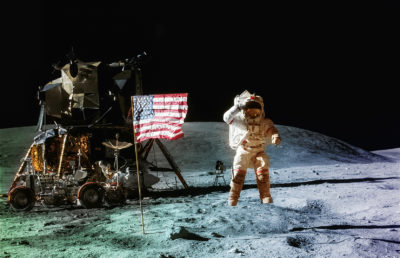In an age of exponential growth, the power of quantitative science to upend our lives is profound, but we can use disruptive technologies to drive positive change if we embrace the Quantasaurus.
It often seems these days that whether a story is about markets, macroeconomics, politics or pop culture, we are left with a hangover of anxiety. Of course, history has long featured turbulence, conflict and disruption. Today, however, we suffer from a particularly acute sense that technology has unleashed forces we cannot control. It frightens us.
As a computer scientist and a quantitative trader, I have long thought about technology and the disruption it leaves in its wake. I’ve often envisioned the march of technology as a dinosaur stalking its slower-moving peers. I even came up with a name for the beast: the Quantasaurus, suggesting the profound change quantitative fields, from data science to artificial intelligence, threaten to usher in — changes that many fear but I believe may in time improve our lives.
The disruption wreaked by the Quantasaurus (not to be confused with the Australian dinosaur Qantassaurus, which, of course, now is extinct) is real. We live in an age of exponential growth. Data, connectivity, computing power and complexity are all growing not just in a linear fashion — say, by 10 percent a year — but exponentially. That kind of change rewrites the rules. Companies that harness that power — Apple, Amazon, Alphabet, Facebook, Netflix and many you may never have heard of — have the best chance to own that future, and are producing the bulk of new high-paying jobs.
If we are to avoid decline or extinction, we must embrace the changes the Quantasaurus visits upon us. The Quantasaurus has the potential to create far more than it destroys. The Quantasaurus will survive, but if we choose to pen it up or flee from it, we will surrender many of its benefits.
How do we domesticate the Quantasaurus? How can we prevent disruptive technologies from destroying livelihoods and instead use them to inspire innovation and adaptation?
We have powerful new tools that can transcend the destruction of labor by technology, which has been feared for centuries. Supercomputers searching out patterns in an expanding universe of data are fueling innovation that will create more than it will destroy. These tools offer the possibility of more effective prediction, whether it’s about the cancer lurking in a patient’s genome, the nascent earthquake locked in tectonic plates or the turbulent ebb and flow of markets.
Three key efforts need to be undertaken to use disruptive technologies to drive positive change.
First, government must reach out to industry. Government programs that partner with industry can be designed to help citizens adapt.
Last month, at the Milken Institute Asia Summit in Singapore, I met Josephine Teo, a minister in Singapore’s Manpower and Foreign Affairs ministries, who spoke of her country’s initiative to create “transformation maps” for industry sectors — transportation, finance, health care, retail and others — to analyze how each is being affected by technological disruption and suggest steps to improve innovation and productivity.
Ms. Teo noted that the future might seem frightening but the outlook for jobs is not all gloomy. A focus on education and retraining from the government, combined with innovative businesses driving the demand for those workers, creates a much more promising future.
Second, technology companies must partner with companies in other fields.
My firm, WorldQuant, has recently embarked on a collaboration with Weill Cornell Medicine in New York to share our cutting-edge technology so that it can be applied to predictive medicine. Some of the tools we use to find market patterns are now analyzing disease progression, particularly as biologists sort through the enormous database of the genome.
Machine learning can help scientists predict how diseases like cancer develop and evolve, how patients respond to therapy and how and why drug resistance occurs. Christopher Mason and Olivier Elemento, co-directors of the effort at Weill Cornell, and their teams are exploring ways to translate WorldQuant algorithms and data models into “precision medicine” — understanding how genetic factors drive disease in individual patients.
Our collaboration with Weill Cornell is just the start. We need many similar experiments, such as the Partnership on Artificial Intelligence, which is bringing leading tech companies, including Google, Facebook, IBM and Microsoft, together with nonprofit organizations to develop AI solutions to improve people’s lives.
Third, we need to broaden opportunities and tap into pools of talent that exist around the world and at home.
The disciplines that drive disruptive change are quantitative and can be taught: computer science, data science, artificial intelligence and machine learning. These fields speak the language of probability and statistics, mathematics and physics, and open up a world that’s complex yet full of possibilities.
The way to thrive is to make these subjects as broadly available as possible — to nurture quantitative literacy — and that means keeping it accessible. American universities are wonderful centers for learning, but access to education still remains an obstacle for many today due to a range of factors, including cost and location. There should never be barriers to learning.
The Quantasaurus is here to stay. We should get to know it better.
Igor Tulchinsky is the Founder, Chairman and CEO of WorldQuant.




